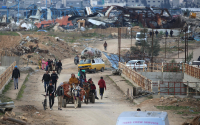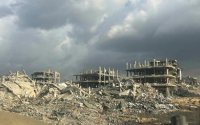Cathrine Philipwww.timesonline.co.uk/tol/news/world/asia/article6383613.ece
 |
1 Civilian camp Civilian encampments in front of the LTTE (Tamil Tiger) firing positions have taken the brunt of the bombardment aimed at rebel mortars. In effect, they are being used as human shields by the Tigers. Charles Heyman, editor of the Armed Forces of the UK magazine, said that the civilian areas had been destroyed by air-burst mortars, a weapon used by the Sri Lankan Army
2 Tamil Tiger firing positions Two sites identified by the military analysts as LTTE firing position, probably mortar pits. The pits are only yards from the damaged civilian shelters, making it extremely unlikely that the Tigers' munitions would have caused the damage because the range of their weapons would have cleared the beach perimeter.
Three independent defence analysts concurred that the likelihood of the LTTE being responsible for that destruction was negligible. While there is no evidence that the Sri Lankan Army deliberately fired on civilians, legal and military experts told The Times that the use of such imprecise weapons was done in the knowledge that it could incur substantial civilian casualties
3 Arms trailer Trailer used by the Tamil Tigers for moving ammunition and supplies around the camp. The trailer has no motor and would need to be dragged by another vehicle
4 Tiger bunker A bunker dug into the beach is probably an LTTE command post. It is set apart from the firing position to protect it when the mortars are fired on by the Sri Lankan Army
5 Sea The LTTE firing positions are less than 300 yards from the shoreline, leaving the Tigers with no escape route as the Sri Lankan military closed in
6 Bulldozer A bulldozer is hidden in the trees. Likely to have been used by the Tamil Tigers for constructing the LTTE bunker and for dragging the ammunition trailer around the site






